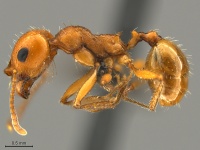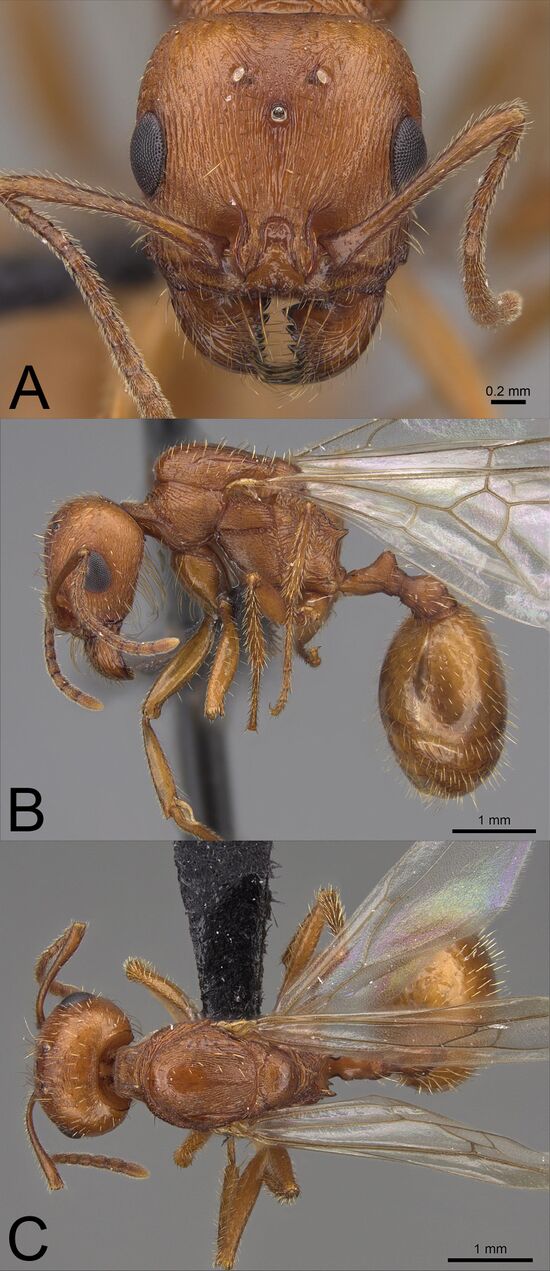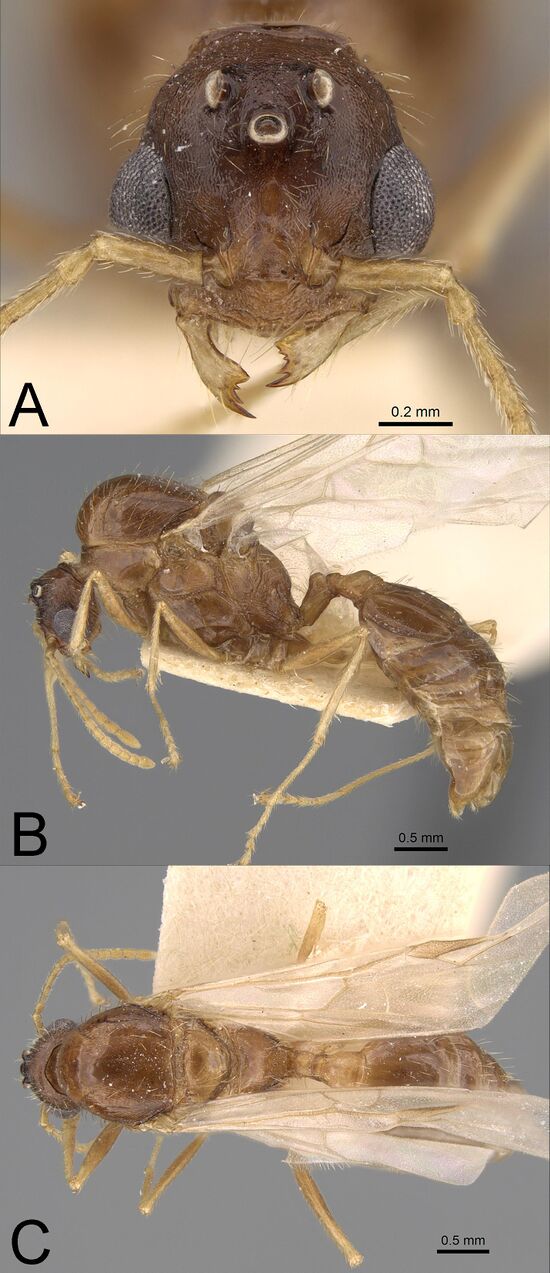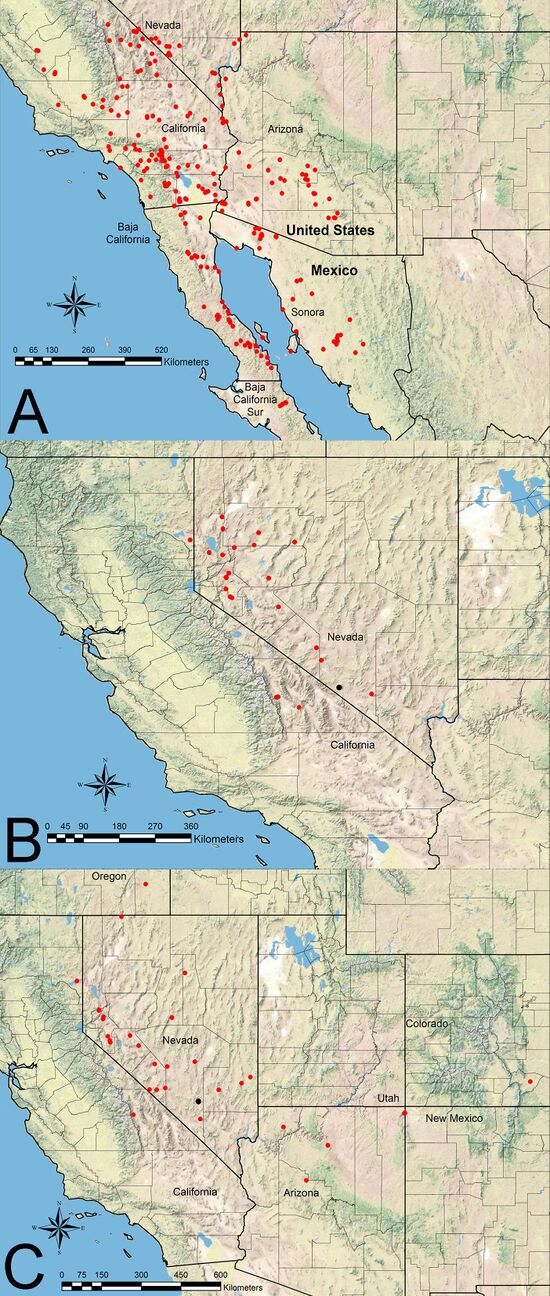Veromessor smithi
| Veromessor smithi | |
|---|---|

| |
| Scientific classification | |
| Kingdom: | Animalia |
| Phylum: | Arthropoda |
| Class: | Insecta |
| Order: | Hymenoptera |
| Family: | Formicidae |
| Subfamily: | Myrmicinae |
| Tribe: | Stenammini |
| Genus: | Veromessor |
| Species: | V. smithi |
| Binomial name | |
| Veromessor smithi Cole, 1963 | |
Little is known about the biology of V. smithi. Workers are solitary, crepuscular and nocturnal foragers (Cole, 1963; 1966; M. Bennett, pers. comm.). Nests are placed in open, exposed areas and typically consist of one to two small circular craters about 10–15 cm in diameter (Cole, 1966). Colonies are small, with one excavated colony containing 275 workers, 1 dealate queen, 27 alate queens, and 97 males (Cole, 1963) (Johnson et al., 2022).
Identification
Worker
This species is uniquely characterized by the following combination of features (Johnson et al., 2022):
- Yellowish red or dull reddish to reddish-brown
- Medial lobe of clypeus smooth and shining, sometimes with rugae anterad, medial lobe not thick and protuberant in profile, not elevated above lateral lobes in frontal view, anteromedial margin often sharply depressed
- Mandibles with 8, or rarely 9 teeth
- Dorsal base of scape flattened and notably widened; maximum basal width of scape greater than maximum preapical width
- MOD less than to greater than OMD, OI > 24.5
- Cephalic dorsum with prominent, wavy, longitudinal rugae that diverge toward posterior corners, rugae posterior to eyes usually becoming more irregular, often with short lateral branches, rugae sometimes fading or disappearing along posterior margin, becoming punctulate-granulate; interrugae on cephalic dorsum weakly coriarious or weakly granulate, weakly shining
- Psammophore moderately well developed; ventral surface of head capsule with both J-shaped hairs and straight or evenly curved hairs, J-shaped hairs arranged in a V-shaped row which does not reach the posterior part of the lateroventral margin of the head capsule
- Dorsum of pronotum with strongly irregular rugae to rugoreticulate, interrugae weakly to strongly coriarious or weakly granulate; sides of pronotum with strongly irregular rugae to weakly rugoreticulate, interrugae strongly granulate; mesonotum with strongly irregular longitudinal trending rugae to rugoreticulate; mesopleura with strongly irregular rugae to rugoreticulate dorsad, rugae mostly longitudinal ventrad, interrugae granulate
- Propodeal spines triangular, acuminate; length less than to sometimes approaching the distance between their bases; infraspinal facet and propodeal declivity weakly sculptured, strongly shining
- Metasternal process small, more of less coniform, about as long as high, apex acuminate to bluntly subangulate (Figures 6D, 45)
 Johnson et al, 2022, Fig. 6. Photographs of the four categories of increasing psammophore development for species of Veromessor based on number and distribution of long J-shaped hairs on the ventral surface of the head capsule (= hypostomal region) (see text). Photograph of: (A) V. chicoensis (CASENT0923125)—J-shaped hairs mostly absent with scattered straight or evenly curved hairs, (B) V. andrei (CASENT0923140)—J-shaped hairs present but not arranged in a distinct row, usually mixed with straight or evenly curved hairs, (C) V. chamberlini (CASENT0761101) and (D) V. smithi (CASENT0923131)—J-shaped hairs present, arranged in a V-shaped row which does not reach the posterior part of the lateroventral margin of head capsule, usually mixed with straight or evenly curved hairs, and (E) V. pergandei (CASENT0923124)—J-shaped hairs present, many long J-shaped hairs arranged in a distinct row around the outer margin of the ventral region of the head capsule. Photographs by Wade Lee from www.AntWeb.org.
Johnson et al, 2022, Fig. 6. Photographs of the four categories of increasing psammophore development for species of Veromessor based on number and distribution of long J-shaped hairs on the ventral surface of the head capsule (= hypostomal region) (see text). Photograph of: (A) V. chicoensis (CASENT0923125)—J-shaped hairs mostly absent with scattered straight or evenly curved hairs, (B) V. andrei (CASENT0923140)—J-shaped hairs present but not arranged in a distinct row, usually mixed with straight or evenly curved hairs, (C) V. chamberlini (CASENT0761101) and (D) V. smithi (CASENT0923131)—J-shaped hairs present, arranged in a V-shaped row which does not reach the posterior part of the lateroventral margin of head capsule, usually mixed with straight or evenly curved hairs, and (E) V. pergandei (CASENT0923124)—J-shaped hairs present, many long J-shaped hairs arranged in a distinct row around the outer margin of the ventral region of the head capsule. Photographs by Wade Lee from www.AntWeb.org.
Queen
This caste is diagnosed by the following combination of features (Johnson et al., 2022):
- Light ferruginous orange to orangish-red, gaster sometimes light orangish-brown
- Medial lobe of clypeus mostly smooth and shining or rarely with irregular rugae, medial lobe not thick and protuberant in profile, not elevated above lateral lobes in frontal view
- Mandibles with 8 teeth
- Dorsal base of scape flattened and widened; maximum basal width of scape greater than maximum preapical width
- MOD slightly greater than OMD
- Cephalic dorsum with longitudinal rugae that diverge toward posterior corners with rugae usually weakening to disappearing posterior to ocelli, weakly punctate-granulate, weakly shining; interrugae on cephalic dorsum weakly punctulate, weakly shining
- Psammophore moderately well developed
- Mesocutum and mesoscutellum smooth and shining with scattered piligerous punctures; anepisternum weakly shining and densely punctate between longitudinal rugae; katepisternum shinier, with weaker rugae or mostly granulate, but usually smooth and arugose anteroventrally
- Propodeum with weak irregular longitudinal and oblique rugae; propodeal spines triangular, acuminate, length about the same as width at base; length much less than distance between their bases; interspinal surface and propodeal declivity weakly coriarious, shining
- Metasternal process small, more or less coniform, about as long as high, apex acuminate to bluntly subangulate (Figure 46).
Male
This caste is diagnosed by the following combination of features (Johnson et al., 2022):
- Yellowish-brown to light medium brown
- Medial lobe of clypeus abruptly depressed across anterior margin, anterior margin straight across middle
- Preapical tooth small; mandibles with one or two minute denticles or teeth basad of preapical tooth
- Anterior ocellus above level of top of eyes
- Mesopleura very weakly sculptured, but anepisternum usually punctulate and with some widely spaced, very fine rugae; katepisternum mostly smooth and shining to weakly roughened
- Propodeum weakly sculptured with some widely spaced, longitudinal rugae; spines or denticles absent; in profile, juncture of dorsal surface and propodeal declivity rounded to subangulate, #Metasternal process elongate, slender, often with a withered look
- Subpetiolar process short, triangular to spine-like (Figures 1I, 47).
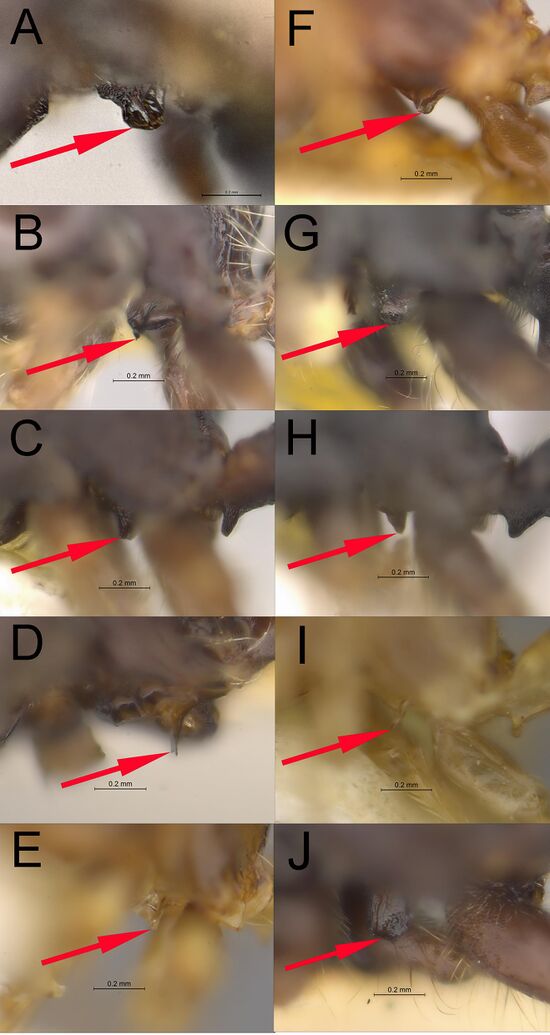 Johnson et al., 2022, Fig. 1. Photographs of the metasternal process on males of Veromessor: (A) V. andrei (CASENT4010823), (B) V. chamberlini (UCRC_ENT00500152), (C) V. chicoensis (CASENT0869853), (D) V. julianus (LACMENT359792), (E) V. lariversi (CASENT0761204), (F) V. lobognathus (LACMENT363986), (G) V. pergandei (CASENT0869850), (H) V. pseudolariversi (CASENT0869851), (I) V. smithi (LACMENT364071), and (J) V. stoddardi (LACMENT364102). Photographs by Robert Johnson from www.AntWeb.org.
Johnson et al., 2022, Fig. 1. Photographs of the metasternal process on males of Veromessor: (A) V. andrei (CASENT4010823), (B) V. chamberlini (UCRC_ENT00500152), (C) V. chicoensis (CASENT0869853), (D) V. julianus (LACMENT359792), (E) V. lariversi (CASENT0761204), (F) V. lobognathus (LACMENT363986), (G) V. pergandei (CASENT0869850), (H) V. pseudolariversi (CASENT0869851), (I) V. smithi (LACMENT364071), and (J) V. stoddardi (LACMENT364102). Photographs by Robert Johnson from www.AntWeb.org.
Identification Notes
Veromessor smithi is broadly sympatric with several congeners including Veromessor lobognathus, Veromessor lariversi and Veromessor pseudolariversi. Workers of Veromessor smithi are separated from V. lobognathus based on: (1) propodeal spines short, length less than distance between their bases and length < 0.5× MOD, (2) eyes larger (MOD = 0.38–0.49, OI = 24.8–33.5), and (3) area between eyes and frontal lobes weakly coriarious and weakly shining to shining between faint to prominent weakly irregular to regular rugae. In V. lobognathus: (1) propodeal spines longer, length greater than distance between their bases and length > 1.0× MOD, (2) eyes smaller (MOD = 0.31–0.41, OI = 20.5–25.0), and (3) area between eyes and frontal lobes strongly granulate and dull between prominent strongly irregular rugae to weakly rugoreticulate.
Workers of Veromessor smithi are separated from Veromessor lariversi and Veromessor pseudolariversi by: (1) larger in size (HW = 1.33–1.61 mm), (2) concolorous orangish-brown to rust colored, (3) maximum basal width of scape greater than maximum preapical width, and (4) mandibles with 8, or rarely 9 teeth. For V. lariversi and V. pseudolariversi: (1) smaller in size (HW = 0.93–1.37 mm), (2) body concolorous light yellowish to yellowish-orange or yellowishred, gaster often slightly darker, (3) maximum basal width of scape less than maximum preapical width, and (4) mandibles with 7 teeth.
A molecular phylogeny that used UCEs shows V. smithi and V. lobognathus are sister lineages (M.L. Borowiec, unpub. data, in Johnson et al., 2022).
 Johnson et al., 2022, Fig. 55. Bivariate plots for workers showing head width versus head length (left panels) and mesosoma length versus pronotum width (right panels) for ecologically similar pairs of small colony species of Veromessor: V. lariversi and V. pseudolariversi (A–B), V. lobognathus and V. smithi (C–D), V. chicoensis and V. stoddardi (E–F). Note that the x-axis scale is the same for all panels on the left and for all panels on the right so that sizes can be compared directly across species groups. Sample size for each species is given in parentheses.
Johnson et al., 2022, Fig. 55. Bivariate plots for workers showing head width versus head length (left panels) and mesosoma length versus pronotum width (right panels) for ecologically similar pairs of small colony species of Veromessor: V. lariversi and V. pseudolariversi (A–B), V. lobognathus and V. smithi (C–D), V. chicoensis and V. stoddardi (E–F). Note that the x-axis scale is the same for all panels on the left and for all panels on the right so that sizes can be compared directly across species groups. Sample size for each species is given in parentheses. Johnson et al., 2022, Fig. 53. Eye area (mm2) (A), facet number (B), and mean facet diameter (μm) (C) for pale and dark colored species of Veromessor. Two species are pale (V. lariversi, V. pseudolariversi—open symbols and regular font), while the other eight species are dark (filled symbols and bold font). For each species, number of workers examined and number of colonies they were derived from is given in parentheses. Significant differences (P < 0.05) among species are denoted after each species name by the letters a–g: a > b > c > d > e > f > g; the three sets of letters for each species correspond to panels A, B, and C, respectively. Groupings are based on univariate F tests within MANCOVA followed by pairwise comparisons using a least significant differences test (see also Johnson & Rutowki, 2022).
Johnson et al., 2022, Fig. 53. Eye area (mm2) (A), facet number (B), and mean facet diameter (μm) (C) for pale and dark colored species of Veromessor. Two species are pale (V. lariversi, V. pseudolariversi—open symbols and regular font), while the other eight species are dark (filled symbols and bold font). For each species, number of workers examined and number of colonies they were derived from is given in parentheses. Significant differences (P < 0.05) among species are denoted after each species name by the letters a–g: a > b > c > d > e > f > g; the three sets of letters for each species correspond to panels A, B, and C, respectively. Groupings are based on univariate F tests within MANCOVA followed by pairwise comparisons using a least significant differences test (see also Johnson & Rutowki, 2022).
Keys including this Species
Distribution
Veromessor smithi occurs at elevations from 760–2,275 m. It appears to be most common in pinyon pine-juniper habitats similar to those inhabited by Veromessor lobognathus. Collections from southwestern Oregon, northwestern New Mexico, and southcentral Colorado indicate that V. smithi is much more widely distributed than indicated by current records, and it also likely occurs in Utah and western Colorado. This species occurs in the Great Basin shrub steppe, Snake–Columbia shrub steppe, Colorado Plateau shrublands, Arizona Mountains forests, Western short grasslands, and Mohave desert ecoregions, as defined by Olson et al. (2001); the two Mohave desert records are from mid-elevations (Figure 41C) (Johnson et al., 2022).
Latitudinal Distribution Pattern
Latitudinal Range: 43° to 35°.
| North Temperate |
North Subtropical |
Tropical | South Subtropical |
South Temperate |
- Source: Johnson et al., 2022
Distribution based on Regional Taxon Lists
Nearctic Region: United States (type locality).
Distribution based on AntMaps
Distribution based on AntWeb specimens
Check data from AntWeb
Countries Occupied
| Number of countries occupied by this species based on AntWiki Regional Taxon Lists. In general, fewer countries occupied indicates a narrower range, while more countries indicates a more widespread species. |

|
Estimated Abundance
| Relative abundance based on number of AntMaps records per species (this species within the purple bar). Fewer records (to the left) indicates a less abundant/encountered species while more records (to the right) indicates more abundant/encountered species. |

|
Biology
Nevada, Wheeler and Wheeler (1986) - We have 22 records from 17 widely scattered localities (4,100-6,200 ft.) but none in the northeastern quarter nor along the western border. Three were in the Pinyon-Juniper Biome and 12 in the Cool Desert (3 in Sarcobatus Subclimax, 3 in Atriplex Subclimax, 1 on a revegetating playa, 1 from a disturbed habitat). Six nests were under half-buried stones; 9 were surmounted by craters 5-10 cm in diameter.
Johnson et al. (2022) - Gland chemistry has not been examined in V. smithi. Like other small-colony congeners, workers of V. smithi have a small pygidial gland reservoir and lack a textured tergal cuticle (Hölldobler et al., 2013).
Mating flights have not been observed, but sexuals have been collected in nests from 12 Jun–27 July (Cole, 1966), suggesting that mating flights occur during late June–July. One dealate brachypterous queen was also examined by RAJ (RAJC; Wheeler and Wheeler NEV#1709).
Castes
  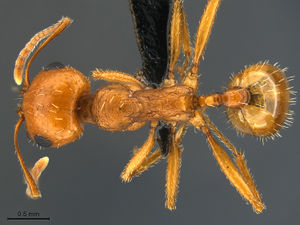 
| |
| . | Owned by Museum of Comparative Zoology. |
Images from AntWeb
   
| |
| Worker. Specimen code casent0005734. Photographer April Nobile, uploaded by California Academy of Sciences. | Owned by UCDC, Davis, CA, USA. |
Nomenclature
The following information is derived from Barry Bolton's Online Catalogue of the Ants of the World.
- smithi. Veromessor smithi Cole, 1963: 678, figs. 1-4 (w.q.m.) U.S.A. (Nevada).
- Type-material: holotype worker, paratype workers, paratype queens, paratype males (numbers not stated, “a long series”).
- Type-locality: holotype U.S.A.: Nevada, Mercury, U.S. Atomic Energy Commission test site, 1962 (A.C. Cole); paratypes with same data.
- Type-depositories: LACM (holotype); AMNH, DRIR, FMNH, LACM, MCZC, USNM (paratypes).
- Wheeler, G.C. & Wheeler, J. 1972b: 240 (l.).
- Combination in Messor: Bolton, 1982: 341 (in text);
- combination in Veromessor: Ward, et al. 2015: 73.
- Status as species: Cole, 1966: 11 (in key); Smith, M.R. 1967: 353; Hunt & Snelling, 1975: 21; Smith, D.R. 1979: 1365; Wheeler, G.C. & Wheeler, J. 1986g: 40; Bolton, 1995b: 257; Ward, 2005: 66.
- Distribution: U.S.A.
Type Material
- Holotype worker [LACM: LACMENT164497]: UNITED STATES, Nevada: Nye County, Nevada Test Site, Area 12 desert near Mercury, 3300’, 15 July 1962 (A.C. Cole NEV-721).
- Paratype series from same locality, 15 July 1962—A.C. Cole NEV-722: LACM (3 workers, 3 alate queens, 6 males): 17 July 1962—A.C. Cole NEV-739: USNM (101 workers, 7 alate queens, 1 dealate queen, 4 males); 4 July 1962—A.C. Cole NEV-741: LACM (4 workers, 3 alate queens, 1 male), UAIC (4 workers); 20 June 1962—A.C. Cole NEV-744: LACM (6 workers); 20 Jun 1962—A.C. Cole NEV-745: LACM (6 workers); 20 June 1962—A.C. Cole NEV-757: LACM (1 worker, 1 alate queen, 1 male); 20 June 1962—A.C. Cole NEV-758: LACM (3 workers, 3 alate queens, 3 males); 23 Jun 1962—A.C. Cole NEV-759: LACM (4 workers, 1 alate queen, 1 male).
The type locality for V. smithi is the Nevada Test Site in Area 12 (= Rainier Mesa), which is along the northern edge of the Nevada Test Site (Johnson et al., 2022).
Description
References
- Bolton, B. 1982. Afrotropical species of the myrmecine ant genera Cardiocondyla, Leptothorax, Melissotarsus, Messor and Cataulacus (Formicidae). Bulletin of the British Museum (Natural History). Entomology, 46: 307-370 (page 341, Combination in Messor)
- Cole, A. C., Jr. 1963a. A new species of Veromessor from the Nevada Test Site and notes on related species (Hymenoptera: Formicidae). Ann. Entomol. Soc. Am. 56: 678-682. (page 678, figs. 1, 2, 3 worker, queen, male described)
- Johnson, R.A., Borowiec, M.L., Snelling, R.R., Cole, A.C. 2022. A taxonomic revision and a review of the biology of the North American seed-harvester ant genus Veromessor (Hymenoptera: Formicidae: Myrmicinae). Zootaxa 52061, 1-115 (doi:10.11646/zootaxa.5206.1.1).
- Plowes, N. J. R.; Johnson, R. A.; Hölldobler, B. 2013. Foraging behavior in the ant genus Messor (Hymenoptera: Formicidae: Myrmicinae). Myrmecological News 18:33-49. [2013-03-22] PDF 142390
- Plowes, N.J.R., Johnson, R.A., Holldobler, B. 2013. Foraging behavior in the ant genus Messor (Hymenoptera: Formicidae: Myrmicinae). Myrmecological News 18, 33-49.
- Ward, P.S., Brady, S.G., Fisher, B.L. & Schultz, T.R. 2014. The evolution of myrmicine ants: phylogeny and biogeography of a hyperdiverse ant clade (Hymenoptera: Formicidae). Systematic Entomology, DOI: 10.1111/syen.12090
- Wheeler, G. C. and J. Wheeler. 1986. The ants of Nevada. Natural History Museum of Los Angeles County, Los Angeles.
- Wheeler, G. C.; Wheeler, J. 1972b. Ant larvae of the subfamily Myrmicinae: second supplement on the tribes Myrmicini and Pheidolini. J. Ga. Entomol. Soc. 7: 233-246 (page 240, larva described)
References based on Global Ant Biodiversity Informatics
- Cole A. C., Jr. 1963. A new species of Veromessor from the Nevada Test Site and notes on related species (Hymenoptera: Formicidae). Annals of the Entomological Society of America 56: 678-682.
- Johnson R. Personnal Database. Accessed on February 5th 2014 at http://www.asu.edu/clas/sirgtools/resources.htm
- La Rivers I. 1968. A first listing of the ants of Nevada. Biological Society of Nevada, Occasional Papers 17: 1-12.
- Wheeler G. C., and J. Wheeler. 1986. The ants of Nevada. Los Angeles: Natural History Museum of Los Angeles County, vii + 138 pp.
